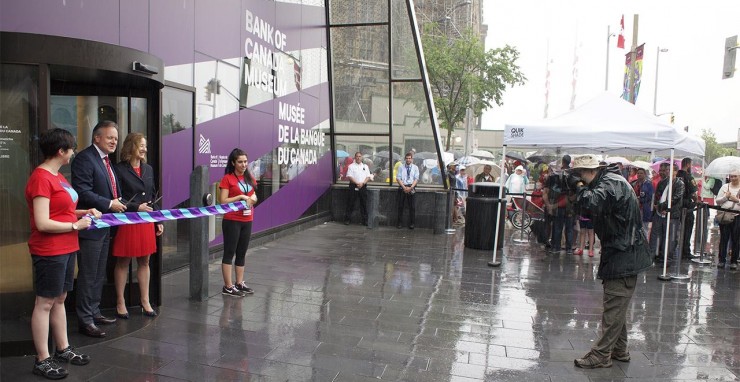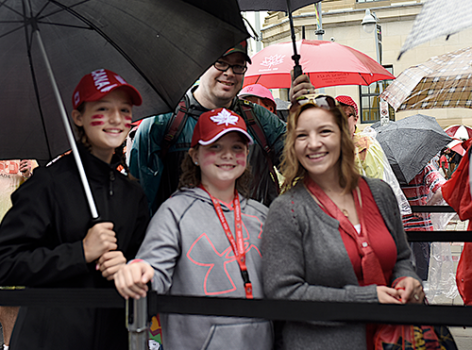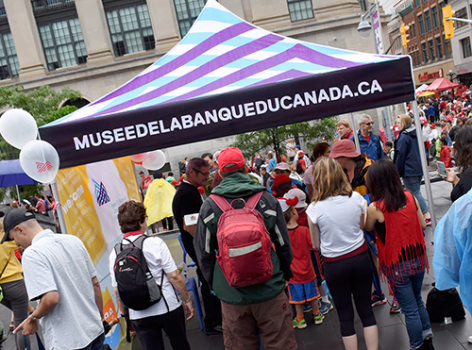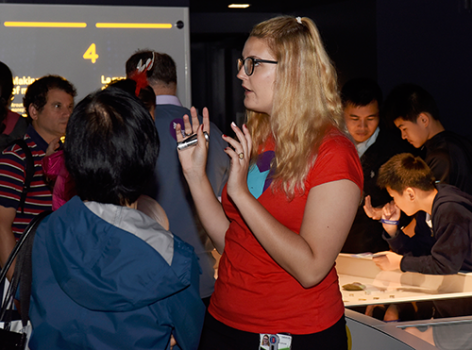Couldn’t have gone better
After four years of plans, worries, setbacks, successes and sheer hard work, the Bank of Canada Museum opened its doors—on Canada Day, right on schedule. Whew! Our future began with a ribbon cutting. And no, the deed was not done by the Prince of Wales and the Duchess of Cornwall. The Bank has its own in-house ribbon cutting team, thank you very much, in the form of Governor Stephen S. Poloz with Senior Deputy Governor Carolyn A. Wilkins. They may not be royalty, but it’s nice that our ribbon cutters are both Canadian VIPs and friends.
We are officially open and really wet. Not as wet as our photographer, though.
Since we were expecting around 2,000 visitors, it was an “all hands on deck” day for the opening event. Nearly the entire Museum staff was there, helping kids at the craft tables, working the door, assisting with the interactives or just strolling around and lending a hand where needed. Fortunately, there was no need to employ another nautical term: “all hands to the pumps.” At no time did our opening day resemble a sinking ship—just a crowded one. In fact, keeping the crowds down to our maximum capacity required a fair amount of management in itself but fortunately we did not require a bouncer. To keep the folks in line happy, our roving entertainer was on the plaza, helping the wait times seem as brief as possible.
In fact, a number of things were happening on the plaza where our rather unmissable welcome tent was set up. From under it (a relief for staff no matter what the weather) we distributed our swag: bookmarks, balloons, hand fans, temporary tattoos and cookies—all very popular. The cookie supply actually lasted a surprising amount of time. (about 20 minutes) To be honest, anything longer than fifteen minutes was surprising and it didn’t matter whether the cookie consumers visited the Museum or not. The cookies were simply clever advertising and a whole lot tastier than a brochure or button.
Even though the Museum has a legal capacity of 400 visitors, there are only so many digital label stations or interactive units. We needed a little supplemental labelling of the human variety for this contingency, so our team of guides got a major verbal workout. For the very curious, two of our curators were on hand to explain the significance and history of the artifacts in greater detail. It’s not every day they get to talk to the public about their subject —and they really like their subject. Fortunately, nobody got our Chief Curator going on Japanese Hansatsu paper money or they’d still be there.
The Museum team was joined by a few members of the Bank’s Currency Department. They were promoting the Canada 150 commemorative bank note and along with an information kiosk, had a table where visitors could get a fresh, new commemorative $10 bill. Of course the staff weren’t giving the notes away—visitors had to exchange their old $10 bills for new ones—but it proved a popular feature anyway.
In all, 2,823 people walked through our doors this Canada Day. That’s a major crowd and they sure seemed to have a good time—especially the kids. I doubt that even half our visitors got a chance to fly the 2 per cent rocket and the digital labels proved a bit too popular for most visitors to get a close-up of their favourite artifact, but that was never the point. The point was for people to wander around, learn what we’re about and want to come back and explore the Museum at their leisure. It was really just a big “Hello” to Canadians and there couldn’t have been a better time than when so many thousands of them were in the neighbourhood and in a mood to celebrate.
Bye-bye! Thanks for making our day.
And now we’d like to thank you for visiting us. It was our pleasure and we hope to see you again, soon. Just not all at once, please.
The Museum Blog
The true value of money
By: Graham Iddon
The 1911 silver dollar
By: David Bergeron
Moving mountains
By: Graham Iddon
A mythic metal: Some stories of gold coins
By: Krista Broeckx
Virtual Worlds. Real Economies.
By: Adam Young
Fur Trade Economics
The house the Bank of Canada built
By: Graham Iddon
Value is in the Eye of the Consumer
By: Graham Iddon
Mishap on the dollar
By: Graham Iddon
The Last Smokestack
By: Graham Iddon





















